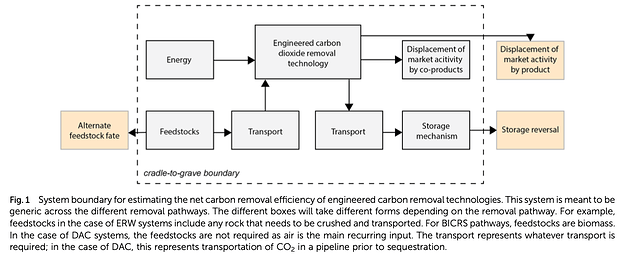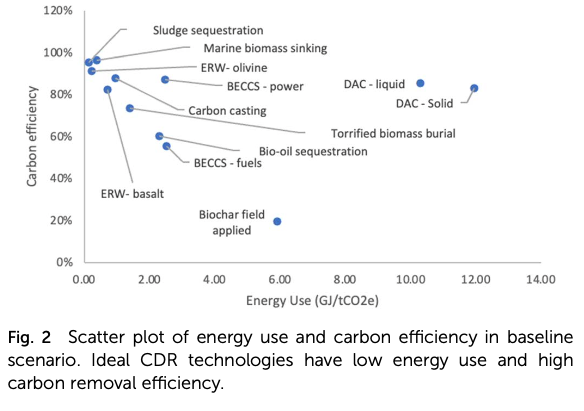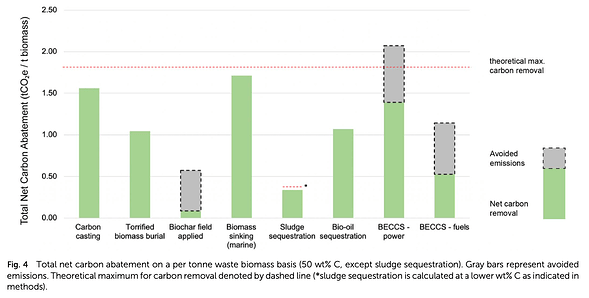This week, we deep dive into a paper recently published in the Royal Society of Chemistry. The study was led by Daniel L. Sanchez, from the University of California-Berkeley, and affiliated with Carbon Direct and Graphyte, in the US.
The study provides a comparative assessment of key engineered carbon dioxide removal (CDR) methods, focusing on their carbon removal efficiencies and associated energy demands. By systematically evaluating technologies such as direct air capture (DAC), bioenergy with carbon capture and storage (BECCS), and enhanced weathering (EW), the authors highlight significant trade-offs between energy input and net carbon removal.
Based on global warming potentials (GWPs) from the 5th IPCC assessment report, technologies’ lifecycle assessment is based on their efficacy at achieving durable carbon removal against their respective life cycle emissions, both direct (on-site) and indirect (supply chain). For the external power required, in the Baseline scenario electricity is sourced from the local eGRID subregion and heat is sourced from unabated natural gas; two additional sensitivity scenarios are explored, in which electricity is provided by renewable electricity and heat is sourced from unabated natural gas (1st sensitivity scenario), or electricity is provided by renewable electricity and heat is sourced from natural gas with carbon capture and storage (2nd sensitivity scenario).
DAC requires significantly more energy than other CDR technologies due to the low atmospheric concentration of CO₂ which makes the capture and storage energy-intensive. In contrast, many of the most energy- and carbon-efficient methods, such as ERW and biomass-based CDR approaches, leverage open, natural systems to passively enhance carbon uptake and storage. This avoids the need for intensive processing or engineered storage, contributing to their lower energy demands and higher carbon efficiency. Biomass approaches, however, exhibit more variation as some biomass conversion processes (e.g., pyrolysis for biochar or gasification for fuels) exhibit high, yet variable, carbon losses.
Displacement of products, when included, increases the total climate benefits of biomass used for bioenergy with carbon capture and storage (BECCS) and biochar. These two measures are intuitive metrics to guide allocation of scarce resources amongst potentially competing uses of biomass and low-carbon energy.
Here is a list of the main takeaways of this paper:
- Carbon removal efficiency varies widely among engineered CDR technologies, with some losing a significant share of captured CO₂ due to upstream and operational emissions.
- Energy requirements are substantial for most high-efficiency CDR methods, especially DAC, which can compromise net removal if powered by fossil-based energy.
- BECCS and enhanced weathering can achieve net-negative emissions, but are constrained by land, biomass availability, and slow geochemical reaction rates.
- Lifecycle assessment is critical to accurately gauge climate benefits, as focusing on gross CO₂ capture can misrepresent actual mitigation potential.
- Policy and deployment strategies must consider both removal efficiency and energy intensity to ensure technologies deliver real climate benefits.
Read the full paper here: Carbon removal efficiency and energy requirement of engineered carbon removal technologies


